
views
Getting to Know Your Character
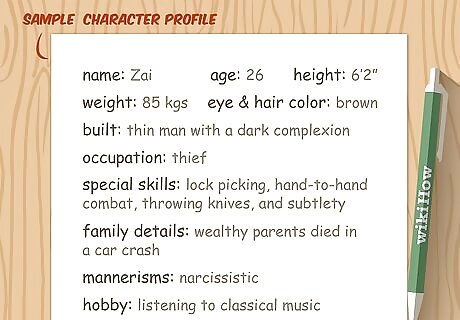
Make a character sheet to develop a well-rounded character. You need to know your main characters, and a character sheet is a good way to build a solid character. Include everything from their physical description to their background, interests, fears, hobbies, and other details. You can create your own character sheet or use a template, which you can find online. Start with the basics, such as height, build, hair color, and eye color. Then, determine other physical details, such as how they stand or what unique features they have. Next, consider how their background, interests, and lifestyle impact their description. For your main characters, provide as much detail as possible on your character sheet. Although you won’t include all of this information in your story, it’s important to know your characters well. EXPERT TIP Grant Faulkner, MA Grant Faulkner, MA Professional Writer Grant Faulkner is the Executive Director of National Novel Writing Month (NaNoWriMo) and the co-founder of 100 Word Story, a literary magazine. Grant has published two books on writing and has been published in The New York Times and Writer’s Digest. He co-hosts Write-minded, a weekly podcast on writing and publishing, and has a M.A. in Creative Writing from San Francisco State University. Grant Faulkner, MA Grant Faulkner, MA Professional Writer Consider their deeper motivations. As the author, you want to know what's driving your character. Your character really isn't just a compilation of character descriptions or physical descriptions; your character is a soul moving through the world. What does that character want and why can't he or she get it? Describe the obstacles blocking your character from reaching what they desire.

Create a sketch of your character for a more visual reference. Draw your character to the best of your abilities, labeling their physical attributes. Write notes on the page about your character’s background, interests, and other descriptive information you want to include. This is a more freeform way to develop your character. It’s okay to use more than one technique. You might find it helpful to make a sketch of your character and then also create a character sheet.

Find a reference photo for your character, as an alternative. You might find it helpful to collect photos of people, places, and things that inspire your writing. Perhaps you want to base your character on someone you know, or maybe a celebrity has the look you want for your main character. Use your inspiration’s photo as a reference when writing your description. If you use reference photos, collect them in a file, either in digital or hard copy form.

Identify what makes your character unique. Every character has quirks that make them different. You can use these quirks to help your reader better imagine your character. Emphasize these quirks over basic descriptors, such as by mentioning a scar on your character’s face. For example, your character might have a mole shaped like a heart, a large tooth gap, or a noticeable limp. Quirks help make your main characters more relatable, and you can also use quirks to quickly characterize side characters.
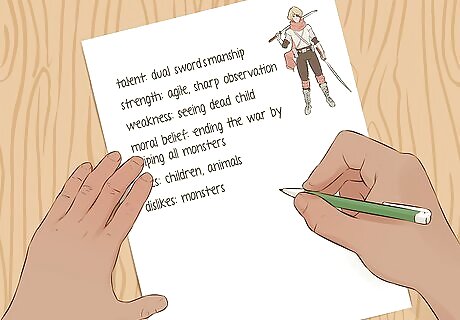
Develop a list of concrete descriptors for your character. You don’t have to use all of them in your story, but it’s handy to have a list of specific descriptive phrases about your character. You can then incorporate the best descriptors into your story. Here are a few examples: A diamond tattoo below his lash line distracted from his aquamarine eyes. Her legs wobbled like stilts. When the wind blows, her hair engulfs her face like a flame.

Avoid using cliches to describe your character or their traits. This applies to both how you introduce the description and the words you use to describe your character. For instance, the most common cliche for introducing a character’s description is the “mirror technique,” which is when you have your character describe themself in a mirror. Examples of description cliches include “red as a rose,” “cold as ice,” or “blind as a bat.”
Incorporating Character Traits in Your Description

Think about how your character might move. How your character moves and what they choose to do tells your reader a lot about them. It also provides descriptive details about your character! Include movement in your description to show your reader more about your character. For example, a character who shuffles will look and act differently from a character who saunters or strides. Maybe your character fidgets or texts a lot. Perhaps they pace around while they talk to people or walk with their head down so they aren’t noticed. Include these types of movement.

Consider their hairstyle. People often choose a hairstyle they think represents them. Your character’s hair cut, hair color, and the way they wear their hair will convey a message to the reader. For instance, a spiky pink mohawk might signify your character is a rebel, while a salon blowout might indicate your character is a queen bee type. You might also use hair style to show your character has different sides to their personality. For example, your main character might be a successful CEO with a sophisticated bob, but they might have a hidden purple streak dyed into their hair or a side undercut that lets them switch their style from board room to rebel.
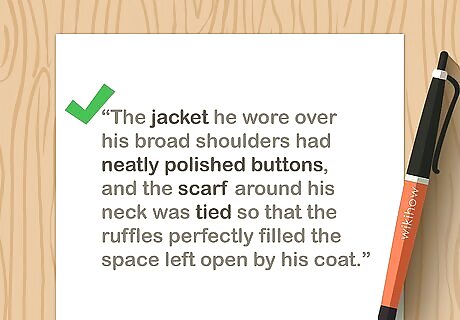
Reflect your character’s personality in their clothing. People also express themselves through their clothing, so use your character’s clothes to show something about their personality. Consider what the reader needs to know about your character to fully understand your plot. It’s also an easy way to characterize side characters. Here’s some examples: A serious character might wear business attire. An artist might wear paint-splattered clothes. Your rock star might wear a leather jacket. A side character who’s a jock might wear sports attire.
Writing Your Description
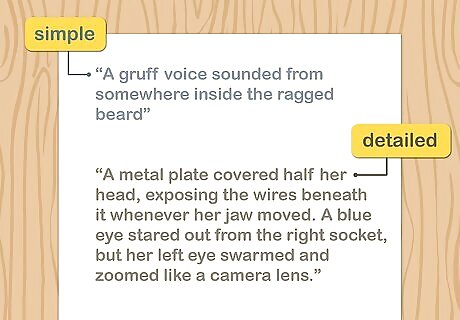
Decide how much description you want to include. You don't want to overload your reader with description. At the same time, you want them to be able to imagine what your character looks like. Consider who your reader is, as well as the genre you're writing. This can help you decide if you want to give a full, detailed description of a character or just enough detail to create an impression. For instance, literary writers usually give less description of their characters. They might tell the reader just enough information for them to get an idea about what the character looks like. For example, "A gruff voice sounded from somewhere inside the ragged beard." On the other hand, genre writers often include more details. For example, a fantasy or sci fi writer would likely give a full description of a character who is non-human, such as a cyborg or elf. You might write, "A metal plate covered half her head, exposing the wires beneath it whenever her jaw moved. A blue eye stared out from the right socket, but her left eye swarmed and zoomed like a camera lens. A long nose pointed down like an arrow over her thin, robotic lips."

Focus on descriptors that characterize rather than minor details. You only want to include information your readers need to know, as it’s impossible to say everything about a character. A good description tells the reader more about your character than how they look. Here are some good examples: “Thick black roots contrasted with the platinum blond shade of her curls.” - This tells the reader that the character dyes her hair but hasn’t been able to keep up with the style. “He wore a sweatshirt advertising a pizza joint that closed three years back. It hung on his lanky frame like a coat hangs on a rack.” - This shows that the character is wearing outdated clothes that don’t fit him, probably because he can’t afford new clothes.

Use figurative language to make your descriptions more engaging. Figurative language uses metaphors, similes, hyperboles, and personification to help the reader imagine the people and events in your story. It allows you to creatively describe your character, rather than listing basic descriptors. For example, you don’t want to say, “Claire has long, brown hair and brown eyes.” Instead, you might write, “Dark curls fell over Claire’s face, masking her amber eyes.” Metaphors and similes both compare two seemingly unlike things, but similes use “like” or “as” to make the comparisons more obvious. Personification gives human characteristics to a non-human animal or thing. For example, “her eyes dodged his questions.”

Avoid purple prose, which means giving too much description. Purple prose is writing that contains a lot of description and fancy words but does little to add to the story. It’s very frustrating for readers, so only include description when it helps you tell your story. You can avoid purple prose by describing only what needs to be described and keeping your descriptions short. Use as few words as possible to get the job done. For example, it's okay to write, "She dyed her hair the color of ink because it made her feel like an artist." You don't need to over-explain like this: "Her inky hair shadowed her pale skin like an oil slick on water. Whenever she looked in the mirror, she saw a romantic poet caught in a different time, making her feel like the artist she always wanted to be."
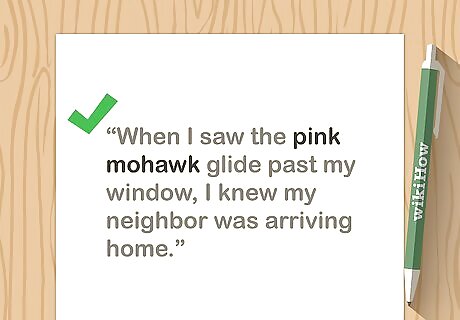
Use synecdoche when one trait represents a character. Synecdoche is a literary device where the writer uses one part of something to represent the entire person, place, or thing. This means you don't have to fully describe a character. Instead, you focus on one prominent trait. It's a convenient way for you to quickly describe a character in a meaningful way but without using many words. Synecdoche is especially useful for side characters! Think about the strong traits that easily identify your character, such as a pink mohawk, a pointy chin, a hunched back, a distinct walk, a unique smell, etc. This trait can be positive or negative, depending on the character. Use this trait when referring to the character. For example, "When I saw the pink mohawk glide past my window, I knew my neighbor was arriving home."

Include sensory details to make your characters come alive. Don’t just list physical characteristics. Appeal to your readers’ 5 senses! You might not include every sense, but include as many as you reasonably can. Appeal to the sense of smell by mentioning how your character smells. For instance, “Mrs. Hamilton always smelled like fresh baked cookies.” Include the sense of touch by mentioning the texture of your character’s scar, or the silky softness of their skin. Activate the sense of sound by relating the sound of your character’s voice to a chirping bird or the growl of an engine. Appeal to their sense of sight by describing your character's clothing and hairstyle. Whenever you can, appeal to the reader's sense of taste. For example, when two characters kiss.

Give descriptors that do double duty rather than a lot of details. Since you don’t want to provide too much description, focus on the details that tell the reader more than one thing about your character. This allows you to better describe your character without overloading the reader with information. For example, "The word that best describes Luna is long. She has a long face, long arms, and long legs that look like stilts."

Pepper your description throughout the story rather than info dumping. You don’t want to overload the reader with information, which is called info dumping. Instead, spread your descriptors over several paragraphs or pages, depending on the length of your work. For example, you might describe your character over the course of a scene rather than all at once.
















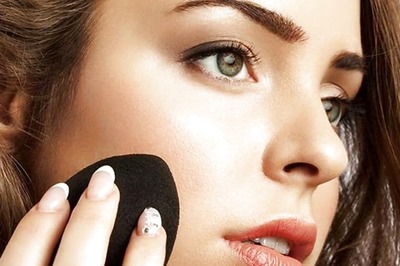



Comments
0 comment